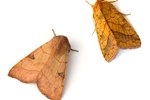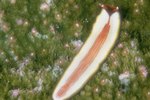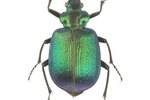
Though moth physiology is in many ways different from our own, they also share some of the same physical characteristics. A moth has a mouth and stomach that he uses to ingest food and nourish himself, a brain and nervous system, and a heart along with a circulatory system that pumps a substance that performs many of the same functions as our blood.
Meet the Moths
Moths are a widely varying group of insects composed of myriad types, from the giant green Luna moth (Actias luna) in the South to the small, household moths that fly into our light fixtures every day. In North Dakota alone, more than 1,400 species of moths from roughly four dozen families exist. They are winged insects that are born flightless, pass through metamorphosis and emerge as adults, which then breed a new cycle.
Moth Blood
Insects do not use blood as we know it; rather, they possess a substance known as hemolymph. It lacks red blood cells and therefore the red color we typically associate with blood. However, they have veins that extend throughout their bodies and into their wings, as well as a main aorta that brings hemolymph up the center of their bodies and supplies their brains, bathing other organs along the way. When moths such as the luna first hatch, they hang upside down for a day or so until hemolymph has flooded their wings, after which they can fly.
Hemolymph and Temperature Regulation
Moths use hemolymph to keep their internal organs healthy and moist, as well as to regulate their body temperature. Just like blood, moths circulate hemolymph faster when they are hot, so that as it passes by their body surface they can give off heat to the surrounding air. Conversely, their circulation slows when they are cold so that they can conserve heat. For this purpose, they have veins that run directly through their muscles on either side of their bodies.
Moth Respiration
While the hemolymph conducts important functions, it is not involved in the circulation of oxygen the way blood is for humans and other mammals. Rather, moths get oxygen through holes in the sides of their bodies called spicules, which route it directly into the trachea. The trachea then transfers oxygen to the internal tissues. Moths are able to adjust the size of spicules so that, depending on the environment, they minimize water loss to hot or arid conditions.
References
- Encyclopedia Brittanica: Insect -- Thorax
- The Children's Butterfly Site: Do Butterflies Have Brains and Hearts?
- University of Nebraska-Lincoln: Chapter 12 -- Temperature Regulation During Flight
- North Dakota State University: Families of Moths
- Fairfax County Public Schools: Luna Moth
- Butterfly Fun Facts: How Do Butterflies and Moths Breathe?
Photo Credits
-
Stockbyte/Stockbyte/Getty Images
Writer Bio
Sarah Moore has been a writer, editor and blogger since 2006. She holds a master's degree in journalism.




